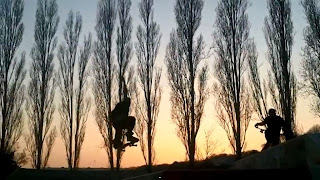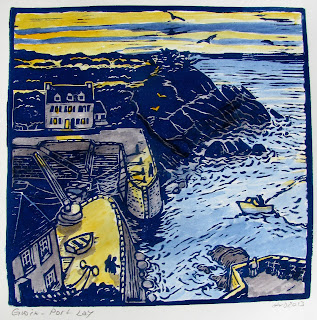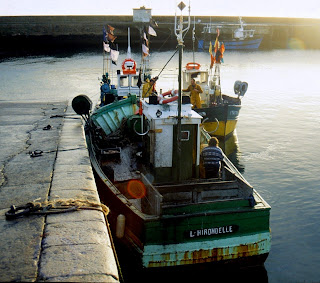At Douarnenez, Port Rhu Wracks
of fisherboates decay since decades. Am Quai de Port Rhu you see sur l'autre cote les bateaux
Crossing at Pont Neuf and
following la Route de Pors an Eostic a small Pfad next to the skate board Platz
leads zum Bootsfriedhof.
„les
épaves se serrent les une contre les autres comme pour se protéger mutuellement
du temps qui passe.“(proposé par olivv).
Diese sites at the
Bretagne like Port Rhu, Camaret, Etel have been documentés at http://www.photographierlabretagne.com/cimetieres_bateaux.php,
and are magische Orte für many fotographers, just few examples are http://www.bateauxdepeche.net/cimbato.htm,
http://www.demain-la-terre.org/IMG/pdf/les_bateaux_en_fin_de_vie.pdf et le livre
Some of les épaves de
Port Rhu are described at http://www.bateauxdepeche.net/cimbato3.htm:
La Brise (1958), Amplitude,
Rouanez Ar Moor, Katie Ann (1921),
L’Elfe de Mer (1964), Saint Quido (1966), Kermoor (1959), Tom
Souville (1952).
PixAile and frederic
(flickr) present aerial views of the site.
Today the kids prefer to practice skate board next to the site,
and in 1995 Douarnenez hosted le coupe de france de skateboard de mini-rampe (see http://ist2011.over-blog.com/495-categorie-12361013.html).
The future is certainly not to be found on a small fishing boat…
A notable example for d'une évasion a été le Biche (hans-bretagne.blogspot.com/2012/08/le-biche-nouveau.html).
The remains have been dissembled completely und dienten als Modelle für die reconstruction.
Some artists have tackled les bateaux pourris, so Port Rhu has attracted
aquarellist Piet Laap (*1943, http://www.pietlap.com/)
, qui représent parfait viele Aspekte
et urban sketcher Monique J, mojilion
The topic Schiffsfriedhof has been rare, und beim
Holzschnitt scheinen die Wracks close to boat (re)construction en raison des contures droites et claires, as
here by Albert Heinzinger (1911-1992):
Ein 1964 Farbholzschnitt von the austrienne Linde Waber
(*1940) zeigt die Umrisse im Kontext der Umgebung:
Ernest Stephen Lumsden (1883-1948) printed his rotting timbers in 1935:
Roderick Fletcher Mead (1900-1971) linked the wreck structure to the spine, Wirbelsäule, so indeed l'épave du navire ressemble à une carcasse
Roderick Fletcher Mead (1900-1971) linked the wreck structure to the spine, Wirbelsäule, so indeed l'épave du navire ressemble à une carcasse
,, as the finnish word Karkass stands for the basic construction of a
house or boat
Animal carcasses serve d'image
pourthe British extreme metal band from
Liverpool
Carcass
And indeed have a forte ressemblance avec des squelettes de bateau, regarde
l‘image de Nikki Biesenieks of a man
preparing a buffalo carcass (Do Son,
Vietnam):
The fate of a boat à la côte bretonne folgt
aus dieser Ansicht von Port Rhu
The frames finally versinken im Schlamm.
Die Vorstufe can be seen in Jean Frelaut’s (1879-1954) Radierung l’épave (dated
1938-46).
Jean was a breton maitre de gravure, and became in 1937 conservateur
du musée de Vannes.
Sur les
sites de
moins d'air and
water impact le bois remains länger, as seen ici at the Ostsee-ile Öland, with
the wreck of 3-Master Swiks (built in
Lettland 1902) stranded in 1926 (stormig jul), the seven-man crew managed to get ashore unharmed par canot de sauvetage. Meine
Skizze von 1985
and the wikipedia image (http://sv.wikipedia.org/wiki/Swiks,
http://de.wikipedia.org/wiki/Trollskogen).
In allen Wracks dominiert the brown red
of iron-ions:
La rouille is
leaking out from the pièces métalliques,
and we thus have a resemblance of animal carcasses with couleur rouge provenant
from the hemoglobin bound iron ions. Die rote
Farbe gibt mir ein feeling of energy content, a sorte de chaleur in
the substance, which will eventually disappear.
Croquis du site has
been done exprimant
le sentiment de cette
assemblée forte de corps de bateaux..
A
main point of the material lino has been to present den Zerfall of the materials.
Thus borders of standing lines and cleared lines have been frayed, fait irrégulière.
Colour has been applied par un pinceau or
if applied by un rouleau structuré
avec une brosse.
Der
Verlust von Farbe und glatter Oberfläche is indicated mit colorisation mince avec le rôle.
As
the boats eventually sink in the mud, the process of cutting feels like digging
away the dirt, archeologically freilegen des skeletons. Here illustré avec un état
préliminaire Probedruck
Variants of the printing include a first plate with
individual colouring of the boats,
a basic brown texturing with later
colouring,
or no colouring at all with all the decaying
mass in red brown.





















































.jpg)




_-_The_Wave_(1896).jpg)





